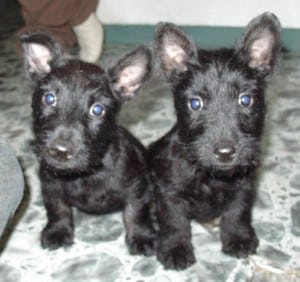From the Desk of Sharda Baker
Good day and welcome everyone!
Hello everyone!
This is Sharda again for another Scottish Terrier newsletter.
One of the first decisions that a prospective dog owner (regardless of breed) has is determining if a male or female dog is the best match.
There are certain characteristics that most male and female dogs will have, and knowing these characteristics will help you make the best choice.
Even if you plan to spay or neuter your Scottie, it is still important to consider the characteristics of male and female dogs, as they will still be present even after the procedure, although the characteristics will not be as pronounced.
Avoid the temptation to just pick the “cutest” puppy or older dog, and try to determine which gender will be the best possible match for you and your family.
So, will it be a Male or Female Scottish Terrier?
MALES
One of the most obvious physical characteristics of the male dog is that it is generally larger than females of the same breed, and eats more. Males are heavier, taller and stronger than female dogs, although this may be particularly of concern more in the larger breed dogs.
Usually the size difference will only be a few inches in height, but it may be more substantial in weight. Male dogs tend to eat significantly more food than non-pregnant females.
Male Scotties may be more aggressive and independent than female dogs. Again, this is a more important consideration in larger breeds than smaller breeds.
Some male dogs tend to be more difficult to manage in small, confined areas and often do not socialize well with other males. This will be particularly true if there are female dogs in the area that are in heat.
A male dog often will form a closer bond with one person, whereas a female dog tends to bond equally with many people.
Male dogs tend to develop quicker sexually than female dogs, and will display sexual tendencies at a younger age.
This is a concern if there are other dogs in the house or in the neighbourhood that may come into heat. The male dogs will tend to roam, as they can smell female dogs in heat for many miles and if allowed, may even be gone for several days in a row in pursuit of females. Neutering your male Scottie will eliminate this problem.
If you choose a Scottie male dog and plan to use him for breeding purposes it will be important to construct a solid fence to contain him, even though he may be small!.
If you purchase a pair of dogs for breeding purposes, it will be important to monitor how aggressive the male becomes when the female is in heat.
You may find that the male becomes very possessive of the female – even towards humans. This may be a concern if you have small children in house, or do not have the dogs kenneled. In addition, the male may become aggressive towards the female if she is not receptive to his advances. Any breeding pair of dogs needs to be carefully monitored.
Male dogs tend to be more difficult to train than female dogs, and are more independent in nature. They also tend to be friskier and require more exercise.
Males may be more difficult to socialize with other animals and other dogs, and need to begin socialization training at a young age.
FEMALES
Female dogs tend to be smaller than male dogs of the same breed and are often less aggressive. However, a female dog protecting a litter of puppies can be just as aggressive as a male.
A female Scottie with her first litter should be carefully monitored for the first few weeks, to see how protective she becomes of the puppies.
Females will come into heat at least twice a year for approximately three weeks. During this time there will be a noticeable discharge of fluid from the female that is designed to attract the male dog.
Spaying the female dog will prevent this from occurring. If the female is to be used for breeding purposes, there are products on the market designed to address this problem.
Female Scotties tend to be less excitable and easier to train. They can, however, become easily cowed or shy if treated harshly, or scolded in a rough or angry tone of voice.
Female dogs tend to bond with many people.
They may be less protective in general than male dogs, however are also easier to socialize with other animals.
Female dogs will fight with other females, but tend to get along generally well with male dogs. Usually a group of female dogs will establish a hierarchy, and will bond with each other after the initial pecking order is established.
SIMILARITIES
With both male and female dogs, it is important to consider the amount of time, attention and effort that will be spent in training the dogs and socializing with them afterwards.
Both male and females require the same amount of exercise, training, feeding, general care, and love. In addition, regular veterinary checkups and yearly vaccinations will be required for both genders.
Deciding on a male or female Scottie is largely a personal decision. Unless the dog is being used for breeding purposes, consideration should be given to spaying or neutering the animal as soon as recommended by your veterinarian, to prevent unwanted pregnancies and puppies.
If the dog is to be used for breeding purposes, it is the responsibility of the owner to keep the dog away from other dogs to prevent unwanted pregnancies.
I hope you learned a lot from today’s Scottish Terrier Newsletter.
All the best and take care
Warmly,
Sharda Baker

